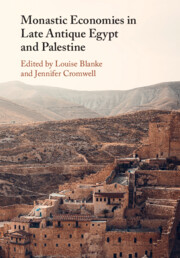Book contents
- Monastic Economies in Late Antique Egypt and Palestine
- Monastic Economies in Late Antique Egypt and Palestine
- Copyright page
- Contents
- Figures
- Tables
- Contributors
- Preface
- 1 The Monastic Economies in Late Antique Egypt and Palestine: Past, Present, and Future
- I. The Monastic Estate
- II. Production and Consumption of Food and Material Goods
- 5 Monastic Vintages: The Economic Role of Wine in Egyptian Monasteries in the Sixth to Eighth Centuries
- 6 Cooking, Baking, and Serving: A Window into the Kitchen of Egyptian Monastic Households and the Archaeology of Cooking
- 7 The Refectory and the Kitchen in the Early Byzantine Monastery of Tell Bi’a (Syria): The Egyptian and Palestinian Connections
- 8 It’s a Dung Job: Exploring Fuel Disc Production in Egyptian Monasteries
- 9 Illuminating the Scriptoria: Monastic Book Production at the Medieval Monastery of St Michael
- III. Monastic Encounters: Travel, Pilgrimage, and Donations
- Glossary
- Index
- References
5 - Monastic Vintages: The Economic Role of Wine in Egyptian Monasteries in the Sixth to Eighth Centuries
from II. - Production and Consumption of Food and Material Goods
Published online by Cambridge University Press: 14 April 2023
- Monastic Economies in Late Antique Egypt and Palestine
- Monastic Economies in Late Antique Egypt and Palestine
- Copyright page
- Contents
- Figures
- Tables
- Contributors
- Preface
- 1 The Monastic Economies in Late Antique Egypt and Palestine: Past, Present, and Future
- I. The Monastic Estate
- II. Production and Consumption of Food and Material Goods
- 5 Monastic Vintages: The Economic Role of Wine in Egyptian Monasteries in the Sixth to Eighth Centuries
- 6 Cooking, Baking, and Serving: A Window into the Kitchen of Egyptian Monastic Households and the Archaeology of Cooking
- 7 The Refectory and the Kitchen in the Early Byzantine Monastery of Tell Bi’a (Syria): The Egyptian and Palestinian Connections
- 8 It’s a Dung Job: Exploring Fuel Disc Production in Egyptian Monasteries
- 9 Illuminating the Scriptoria: Monastic Book Production at the Medieval Monastery of St Michael
- III. Monastic Encounters: Travel, Pilgrimage, and Donations
- Glossary
- Index
- References
Summary
Monastic communities needed wine for individual consumption, as well as for liturgical purposes and payments in kind. Next to grain, wine was the most common commodity transported from different villages to monasteries, as we learn from invoices from Bawit, Wadi Sarga, and Edfu. It is therefore widely assumed that monasteries, especially the more affluent ones, owned vineyards. Following a brief overview of the purposes wine served in monasteries, this chapter presents and reassesses the evidence for monastic vineyard ownership and considers other options available to monks seeking to procure wine for their needs.
Information
- Type
- Chapter
- Information
- Monastic Economies in Late Antique Egypt and Palestine , pp. 129 - 151Publisher: Cambridge University PressPrint publication year: 2023
